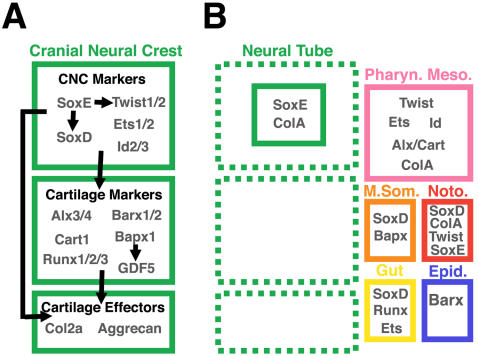File:Neural crest-derived cartilage.jpg
Neural_crest-derived_cartilage.jpg (478 × 356 pixels, file size: 40 KB, MIME type: image/jpeg)
A provisional gene network operating in nascent neural crest-derived cartilage and expression of network component homologs in amphioxus.
(A) We have classified genes in the network as cranial neural crest (CNC) markers, cartilage markers, or effector genes based on their expression, regulatory relationships, and biochemical functions.
Among the CNC markers are Sox9 (SoxE), Sox5/6 (SoxD), Twist1/2 and Ets1/2 genes. All of these factors are expressed in post-migratory chondrogenic cranial neural crest.
SoxE, SoxD, and Twist1/2 have been shown to cross-regulate, and to activate cartilage specifiers and effector genes. SoxE is required for expression of both SoxD and Twist1/2 in migrating CNC, while Twist1/2 is necessary for the continued expression of SoxE in postmigratory CNC. Both SoxE and SoxD cooperate to directly activate the definitive cartilage differentiation marker Col2a1 in chondroblasts, while Twist1/2 is required for expression of the aristalless-related transcription factors Alx3/4 and Cart1.
Ets1/2 expression overlaps temporally and spatially with SoxE, SoxD and Twist1/2, though functional relationships between it and the other network components have yet to be demonstrated. In sea urchins, Ets1/2 and Alx3/4 orthologs are necessary for the formation of skeletogenic mesenchyme and are regulated by the same upstream factors, suggesting they cooperate in an evolutionarily ancient skeletogenic program.
As chondrogenesis begins, presumptive pharyngeal chondrocytes express genes grouped here as cartilage markers (Barx1/2, Alx3/4, Cart1, Runx1/2/3, Bapx1, and GDF5). These genes are expressed in differentiating CNC-derived chondrocytes, are downstream of CNC specfiers and upstream of effector genes like Col2a1 and Aggrecan, Barx1 physically interacts with Sox9 to directly activate Collagen2a1 expression.
As indicated above, Alx3/4 and Cart1 are regulated by Twist1/2. Runx1/2/3 expression in chondrocytes is dependent on SoxE function. In the pharynx, Bapx1 functions mainly to position the jaw joint by regulating expression of GDF5. In the mesoderm-derived axial skeleton, however, Bapx1 is expressed broadly and operates upstream of Sox9, Col2a1, and Runx1/2/3. Essential for maintenance and establishment of the chondrogenic subnetwork are signaling molecules of the FGF and Endothelin families which are secreted by surround pharyngeal endoderm and ectoderm (not shown). These genes also mediate pharyngeal arch patterning by activating nested expression of various transcription factors in the nascent cartilages including Dlx and Msx genes, Gsc, and Hand2 (not shown).
(B) The major expression domains of chondrogenic neural crest gene homologs in amphioxus neurulae and larvae. No single cell type expresses the complete set of vertebrate chondrogenic network genes, indicating the cranial neural crest cartilage program is a vertebrate novelty. Notably, most factors are expressed in mesodermal derivatives, suggesting neural crest-derived cartilage evolved via repeated cooption of primitively mesodermal genes.
PLoS ONE. 2007; 2(8): e787. Published online 2007 August 29. doi: 10.1371/journal.pone.0000787.
http://www.pubmedcentral.nih.gov/articlerender.fcgi?artid=1950077&tool=pmcentrez
Copyright Meulemans, Bronner-Fraser.
This is an open-access article distributed under the terms of the Creative Commons Attribution License, which permits unrestricted use, distribution, and reproduction in any medium, provided the original author and source are credited.
File history
Click on a date/time to view the file as it appeared at that time.
| Date/Time | Thumbnail | Dimensions | User | Comment | |
|---|---|---|---|---|---|
| current | 10:31, 11 September 2009 |  | 478 × 356 (40 KB) | S8600021 (talk | contribs) | A provisional gene network operating in nascent neural crest-derived cartilage and expression of network component homologs in amphioxus. (A) We have classified genes in the network as cranial neural crest (CNC) markers, cartilage markers, or effector ge |
You cannot overwrite this file.
File usage
There are no pages that use this file.
